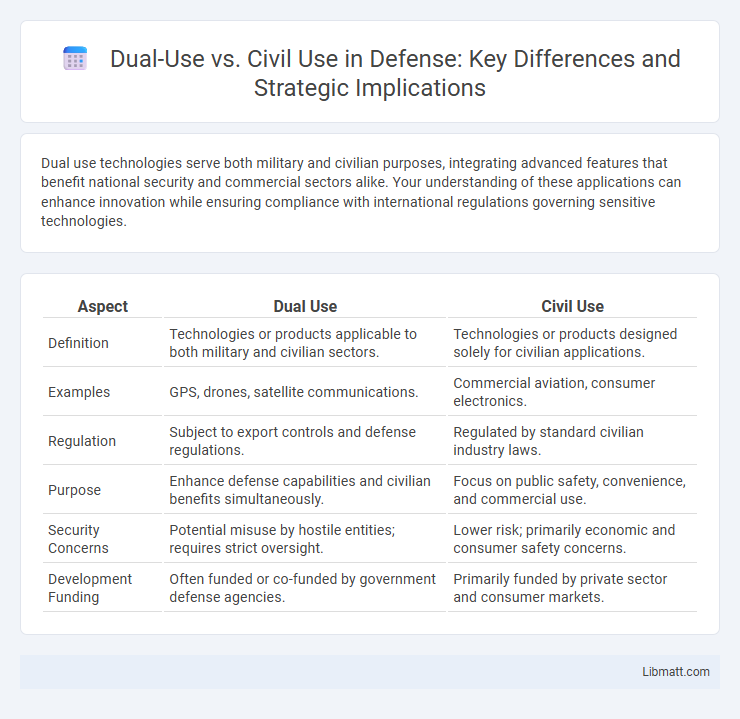Dual use technologies serve both military and civilian purposes, integrating advanced features that benefit national security and commercial sectors alike. Your understanding of these applications can enhance innovation while ensuring compliance with international regulations governing sensitive technologies.
Table of Comparison
| Aspect | Dual Use | Civil Use |
|---|---|---|
| Definition | Technologies or products applicable to both military and civilian sectors. | Technologies or products designed solely for civilian applications. |
| Examples | GPS, drones, satellite communications. | Commercial aviation, consumer electronics. |
| Regulation | Subject to export controls and defense regulations. | Regulated by standard civilian industry laws. |
| Purpose | Enhance defense capabilities and civilian benefits simultaneously. | Focus on public safety, convenience, and commercial use. |
| Security Concerns | Potential misuse by hostile entities; requires strict oversight. | Lower risk; primarily economic and consumer safety concerns. |
| Development Funding | Often funded or co-funded by government defense agencies. | Primarily funded by private sector and consumer markets. |
Introduction to Dual Use and Civil Use
Dual use refers to technologies or products designed for civilian applications but that can also be utilized for military or defense purposes, raising important regulatory and ethical considerations. Civil use encompasses technologies strictly intended for non-military, everyday applications such as healthcare, transportation, and communications. Understanding the distinctions between dual use and civil use helps you navigate compliance requirements and ensure responsible innovation.
Key Definitions: Dual Use vs Civil Use
Dual use refers to goods, technology, or knowledge that can be utilized for both military and civilian applications, often raising regulatory and security concerns due to their potential for weaponization. Civil use pertains exclusively to non-military, peaceful purposes such as commercial, industrial, or scientific activities. Understanding the distinction between dual use and civil use is critical for compliance with export control regulations and international trade policies.
Historical Context of Dual Use Technologies
Dual use technologies, originally developed for military or defense purposes, have historically transitioned into civilian applications such as the internet and GPS systems. The Cold War era accelerated innovations in aerospace, computing, and telecommunications that later spurred commercial advancements and economic growth worldwide. Understanding this historical context highlights the complexities in regulating technologies that serve both defense and civilian sectors.
Regulatory Frameworks for Civil and Dual Use
Regulatory frameworks for civil and dual-use technologies emphasize compliance with international agreements such as the Wassenaar Arrangement and export control laws to prevent misuse while enabling innovation. Dual-use regulation involves stringent licensing procedures to monitor materials and technologies that possess both civilian and military applications. Civil use frameworks prioritize safety, environmental standards, and public accessibility, often governed by agencies like the FDA, FAA, or local regulatory bodies.
Industries Impacted by Dual and Civil Use
Dual use and civil use technologies significantly impact industries such as aerospace, telecommunications, energy, and manufacturing. Your company must navigate regulations as dual use products, which serve both military and civilian applications, often face stricter export controls. The balance between innovation and compliance affects sectors like electronics and software development, where advancing technology drives both commercial growth and defense capabilities.
Risks and Challenges of Dual Use Applications
Dual use applications, which have both civilian and military uses, pose significant risks such as the potential for technology to be repurposed for harmful military or terrorist activities. Challenges include controlling the proliferation of sensitive technologies, ensuring compliance with international regulations, and mitigating misuse without stifling innovation in civilian sectors like medicine, communication, and energy. Robust monitoring frameworks and cooperation between governments, industries, and international bodies are essential to address these risks effectively.
Benefits of Civil Use Innovations
Civil use innovations drive economic growth by enhancing quality of life through advancements in healthcare, transportation, and communication technologies. These innovations foster sustainable development and improve public safety by promoting environmentally friendly solutions and efficient infrastructure. Your access to cutting-edge civil technologies accelerates social progress and supports global connectivity.
Export Controls and Compliance Considerations
Export controls on dual-use goods and technologies require rigorous compliance to prevent unauthorized military applications while maintaining legitimate civil use trade. Companies must implement comprehensive screening protocols aligned with regulations such as the Wassenaar Arrangement and national export control laws to classify and monitor products accurately. Effective compliance programs reduce legal risks and support global security by ensuring sensitive items do not fall into prohibited hands or regions.
Case Studies: Dual Use vs Civil Use in Practice
Case studies reveal distinct challenges when differentiating dual-use technologies from purely civil applications, highlighting sectors such as aerospace and biotechnology where overlap is common. For instance, satellite technology serves both military surveillance and civilian telecommunications, demanding stringent regulatory frameworks to balance national security with commercial innovation. Similarly, CRISPR gene-editing tools exemplify dual-use dilemmas, as they enable medical breakthroughs while posing potential biosecurity risks if misapplied.
Future Trends in Dual Use and Civil Use Technology
Future trends in dual use and civil use technology emphasize the convergence of advanced materials, artificial intelligence, and biotechnology across military and civilian sectors. Innovations in autonomous systems, cybersecurity, and quantum computing are driving transformative applications that enhance national security while promoting economic growth and societal benefits. Regulatory frameworks and ethical considerations are evolving to address the complexities of dual use technologies and their potential risks in a globally interconnected environment.
Dual use vs Civil use Infographic

 libmatt.com
libmatt.com